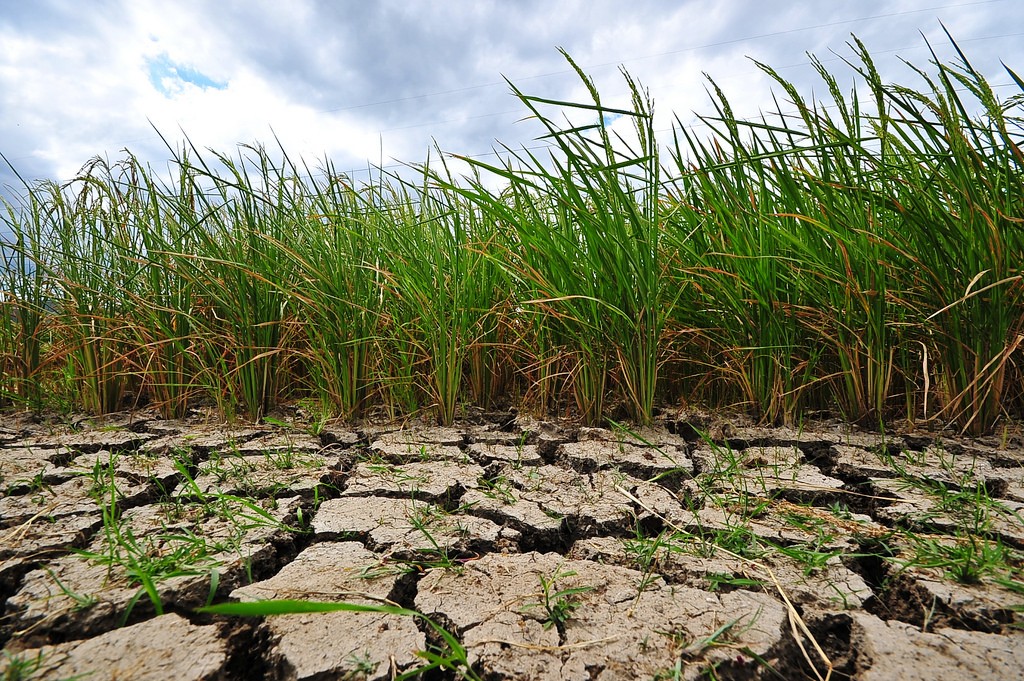Drought incidence in rain-fed areas is the major abiotic stress especially to rice growing in around 23 million ha areas in India, the dry spells of different intensities will be more common in coming years due to climate change. Our 2-year study revealed that besides the use of tolerant cultivars, the application of nutrients also helped the rice plants to overcome the drought stress and its after-effects.
Drought incidence in rain-fed areas is the major abiotic stress especially to rice growing in around 23 million ha areas in India, the dry spells of different intensities will be more common in coming years due to climate change. Out of the 21 million hectares (ha) of rice in India, about 16 million ha is in eastern India and is prone to drought either in upland or in rain-fed lowlands.
 Water-deficit may occur early during the monsoon season or at any time from flowering to grain filling, and the intensity of the stress depends on the duration and recurrence of water paucity. The most crucial stage in crop growth to any stress whether biotic or abiotic is reproductive, so, the dry spell at this stage may be detrimental and led to the failure of crop. The challenges for crop production are even greater for crops such as rice, which is the staple food for more than half of world’s population and is being grown under diverse environmental conditions.
Water-deficit may occur early during the monsoon season or at any time from flowering to grain filling, and the intensity of the stress depends on the duration and recurrence of water paucity. The most crucial stage in crop growth to any stress whether biotic or abiotic is reproductive, so, the dry spell at this stage may be detrimental and led to the failure of crop. The challenges for crop production are even greater for crops such as rice, which is the staple food for more than half of world’s population and is being grown under diverse environmental conditions.
Sustainable production in drought-affected areas can only be achieved through genetic modification of cultivars (i.e. developing drought-tolerant varieties). Currently, most rain-fed areas are planted with high-yielding varieties like IR 36, IR 64, Sambha Mahsuri, TDK 1, and Swarna, which were originally bred for irrigated conditions. These varieties are high yielding but are highly susceptible to drought. In years with mild to moderate drought, these varieties show high yield losses, and in years of severe drought, which occur approximately once in five years in eastern India, these varieties may fail to flower and produce any grain
Despite the internal resistance of the plants to drought stress, the detrimental effects of drought can be minimized by an adequate and balanced supply of mineral nutrients. Increasing evidence suggests that mineral-nutrient status of plants plays a critical role in increasing plant resistance to drought stress.
Water deficit significantly affects the acquirement of nutrients by roots and their movements towards shoots that is why rice growth does not often respond to nutrient input. Drought stress leads to the reduction in transpiration flow due to interference in uptake and unloading mechanisms may result in low absorption of nutrients.
Optimal nutrition greatly affects water circulation within plants, which is a highly effective method of combating drought. Under low nutrient concentrations in soil, plants have to absorb more water to be able to take up the same amount of mineral nutrients for their metabolism than they would from the soil with satisfactory fertility. Hence, plant nutrients like P, K, Ca, Mg, etc. are essential for plant growth, metabolism, and reproduction. These nutrients are an integral part of organic compounds like amino acids, nucleic acids, phospholipids, and proteins. However, rice genotypes may vary in their response to mineral nutrition under water stress.
Notably, recently released drought-tolerant rice cultivars may respond better to nutrient input, and growth and yield may be enhanced under drought, compared with susceptible varieties. The study was planned with the hypothesis that the plant performance under water stress conditions can be improved by internal tolerance combined with exogenous nutrient application. Therefore, the aim of the study was to find out the relevance of metabolic and morphological parameters and its phenotypic plasticity for drought tolerance in different cultivars of rice and exogenous application of different nutrients either alone or in combination.
Our 2-year study revealed that imposition of drought during active growth period significantly influenced the performance of all the rice cultivars but yield penalty was lower in the tolerant cultivar, Sahbhagi dhan. The differential response of cultivars regarding growth, tillering dynamics, physio-biochemical parameters, drought-tolerance indices to imposed stress indicated their drought tolerance ability, which was highest in Sahbhagi dhan.
Besides the tolerant cultivar, the application of nutrients also helped the rice plants to overcome the drought stress and its after-effects. The maximum growth, photosynthesis, chlorophyll, proline, anti-oxidants production, and yield was obtained with combined application of nutrients, especially P and K. As possible technological alternatives, the use of drought-tolerant cultivars associated with the extraneous supply of nutrients, which are not available due to water deficit, may help cope with or at least ameliorate this problem.
Although our insight into how rice plant reacts to stress is increasing, the comprehension of how these changes convert into plant development and yield level contrasts in execution under drought falls behind, so more endeavors ought to be made to examine these reactions on nutrient management.
Read the full study:
Lal B, Gautam P, Nayak AK, Maharana S, Tripathi R, Shahid M et al. (2019). Tolerant varieties and exogenous application of nutrients can effectively manage drought stress in rice. Archives of Agronomy and Soil Science, DOI: 10.1080/03650340.2019.1587749






